Wood Shabti of the Administrator Mahu from Amarna
Culture: Egyptian
Period: New Kingdom, 18th dynasty, Reign of Akhenaten or Smenkhkare, 1351-1333 B.C.
Material: Wood
Dimensions: 27.5 cm high
Price: Sold
Ref: 1545
Provenance: Private collection Spiro, in Europe prior to 1920. Published in Galerie Puhze’s catalogue 22, Freiburg 2008, No. 179. On 24 September 2009 acquired by the German collection Erika Krautkrämer (1932-2022). Thence in a family estate. With a copy of the certificate of authenticity of Galerie Puhze.
Condition: The face possibly in ancient times deliberately slightly rubbed off. Feet worn. Otherwise very beautifully preserved with magnificent age patina.
Description: Historically important wood shabti from Amarna, which originates from the tomb of the overseer Mahu. The slender, elongated face with the typical fine features of the Amarna period with the almond-shaped eyes, curved brows, large mouth with broad lips and prominent chin. The wood figure in mummiform with a black tripartite wig and crossed arms in front of the chest. The shabti holds in each hand a plow for field work. The long body with a small belly and a well-formed backside has a finely engraved hieroglyphic inscription. Parts of the first line with the name and title of the owner were already erased in ancient times and overwritten with ink in Hieratic script – today hardly readable – for a new owner. This probably happened as part of the Damnatio Memoriae, which was imposed on the reign of Akhenaten and his dignitaries after the end of the Amarna period. The name of the administrator Mahu (Ancient Egyptian: M3hw) and his title are mentioned again in the third line of the following shabti quote (6th chapter of the Ancient Egyptian Book of the Dead) and therefore were preserved. An important testimony of one of the most known areas of Ancient Egypt.







